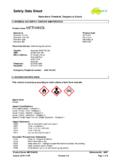Transcription of Material Safety Data Sheet KURE-N-SEAL
1 Material Safety data Sheet KURE-N-SEAL . Version 08/16/2006. 1. PRODUCT AND COMPANY INFORMATION. Company : BASF Building Systems 889 Valley Park Drive Shakopee, MN 55379. Telephone : 952-496-6000. Emergency telephone number : (800) 424-9300. (703) 527-3887 (Outside Continental US). Product name : KURE-N-SEAL . MSDS ID No. : 10995. TSCA Inventory : All components of this product are included, or are exempt from inclusion, in the EPA. Toxic Substances Control Act (TSCA) Chemical Substance Inventory. Canadian DSL : All components of this product are included, or are exempt from inclusion, in the Canadian Domestic Substance List (DSL).
2 Product Use Description : Coating 2. HAZARDOUS INGREDIENTS. Chemical CAS No. TLV STEL PEL CEIL Weight %. SOLVENT NAPHTHA 64742-95-6 - %. (PETROLEUM), LIGHT. AROMATIC. 1,2,4 TRIMETHYL BENZENE 95-63-6 25 ppm - %. 3. HAZARDS IDENTIFICATION. PHYSICAL. HMIS Rating HEALTH FLAMMABILITY HAZARD. 1 2 0. WHMIS Class : B3. Primary Routes of Entry : Skin contact Inhalation Effects of Overexposure Inhalation : Inhalation of high vapor concentrations may cause symptoms like headache, dizziness, tiredness, nausea and vomiting. Inhalation of high vapor concentrations can cause CNS- depression and narcosis. Prolonged inhalation can be harmful.
3 Skin : Prolonged skin contact may defat the skin and produce dermatitis. Prolonged or repeated exposure can cause skin irritation and redness. Eyes : Can cause slight irritation. Ingestion : Can cause slight irritation. Chronic exposure : This product contains solvents . Reports associate repeated and prolonged occupational Page 1 of 6. Material Safety data Sheet KURE-N-SEAL . overexposure to solvents with permanent brain and nervous system damage. Reports also indicate that solvents cause liver damage, kidney damage, and mucous membrane irritation. Be warned that intentional misuse by deliberately inhaling the vapors and/or the product contents (a process often called "sniffing") can be harmful or fatal.
4 Carcinogenicity ACGIH IARC NTP OSHA. SOLVENT NAPHTHA (PETROLEUM), LIGHT AROMATIC. 1,2,4 TRIMETHYL BENZENE 4. FIRST AID MEASURES. Eye contact : Flush eyes with water, lifting upper and lower lids occasionally for 15 minutes. Seek medical attention. Skin contact : Remove contaminated clothing. Wash thoroughly with soap and water. If irritation persists seek medical attention. Wash contaminated clothing before reuse. Ingestion : Do not induce vomiting without medical advice. If conscious, drink plenty of water. If a person feels unwell or symptoms of skin irritation appear, consult a physician. If a person vomits, place him/her in the recovery position.
5 Never give anything by mouth to an unconscious person. Inhalation : Remove victim from exposure. If difficulty with breathing, administer oxygen. If breathing has stopped administer artificial respiration, preferably mouth-to-mouth. Seek immediate medical attention. 5. FIRE-FIGHTING MEASURES. Flash point : F ( C). Autoignition temperature : no data available Lower explosion limit : %(V). Upper explosion limit : 7 %(V). Suitable extinguishing media : water fog carbon dioxide (CO2). dry chemical Fire and Explosion Hazards : Combustible Liquid. Can form explosive mixtures at temperatures at or above the flashpoint.
6 Vapors can travel to a source of ignition and flash back. Empty containers retain product residue (liquid and/or vapor) and can be dangerous. DO NOT. PRESSURIZE, CUT, WELD, BRAZE, SOLDER, DRILL, GRIND, OR EXPOSE SUCH. CONTAINERS TO HEAT, FLAME, SPARKS, STATIC ELECTRICITY, OR OTHER. SOURCES OF IGNITION; CONTAINERS MAY EXPLODE AND CAUSE INJURY OR. DEATH. DO NOT PRESSURIZE, CUT, WELD, BRAZE, SOLDER, DRILL, GRIND, OR. EXPOSE SUCH CONTAINERS TO HEAT, FLAME, SPARKS, STATIC ELECTRICITY, OR OTHER SOURCES OF IGNITION; CONTAINERS MAY EXPLODE AND CAUSE. INJURY OR DEATH. Solid stream of water or foam can cause frothing.
7 Special Fire-fighting Procedures : At higher temperature pressure build up in sealed containers. Use water to cool containers exposed to fire. As in any fire, wear self-contained breathing apparatus pressure-demand (MSHA/NIOSH approved or equivalent) and full protective gear. Page 2 of 6. Material Safety data Sheet KURE-N-SEAL . 6. ACCIDENTAL RELEASE MEASURES. Methods for cleaning up : Ventilate the area and remove all sources of ignition. Evacuate unnecessary personnel. Take action to eliminate source of leak. Large spills should be handled carefully. Put on respiratory protection and necessary personal protective equipment.
8 Dike or impound spilled Liquid. Contain and collect spillage with non-combustible absorbent Material , ( sand, earth, diatomaceous earth, vermiculite) and place in container for disposal according to local / national regulations (see section 13). 7. HANDLING AND STORAGE. Handling : Use only in area provided with appropriate ventilation. Keep out of reach of children. Take precautionary measures against static discharges. Ground and bound containers when transferring Material . For personal protection see section 8. Storage : Keep containers tightly closed in a dry, cool and well-ventilated place.
9 8. EXPOSURE CONTROLS / PERSONAL PROTECTION. Eye protection : Wear as appropriate: Safety glasses with side-shields goggles face-shield Hand protection : Wear Chemically resistant gloves. Body Protection : Wear as appropriate: Chemically resistant clothes preventive skin protection Respiratory protection : In case of insufficient ventilation wear suitable respiratory equipment. When workers are facing concentrations above the exposure limit they must use appropriate certified respirators. Hygienic Practices : Avoid contact with skin, eyes and clothing. Ensure adequate ventilation, especially in confined areas.
10 Wash hands before breaks and at the end of workday. When using, do not eat, drink or smoke. Handle in accordance with good industrial hygiene and Safety practice. Engineering Controls : Local exhaust ventilation can be necessary to control any air contaminants to within their TLVs during the use of this product. 9. PHYSICAL AND CHEMICAL PROPERTIES. Color : white Physical State : liquid Odor : mild solvent pH (at 100 %) : no data available Odor Threshold : no data available Vapor Pressure : no data available Page 3 of 6. Material Safety data Sheet KURE-N-SEAL . Vapor Density : Heavier than air Boiling point/range : - F ( - C).


